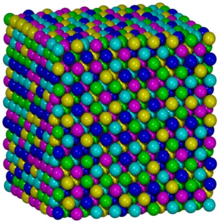
High-entropy alloys (HEAs) are alloys that are formed by mixing equal or relatively large proportions of (usually) five or more elements. Prior to the synthesis of these substances, typical metal alloys comprised one or two major components with smaller amounts of other elements. For example, additional elements can be added to iron to improve its properties, thereby creating an iron-based alloy, but typically in fairly low proportions, such as the proportions of carbon, manganese, and others in various steels.[2] Hence, high-entropy alloys are a novel class of materials.[1][2] The term "high-entropy alloys" was coined by Taiwanese scientist Jien-Wei Yeh[3] because the entropy increase of mixing is substantially higher when there is a larger number of elements in the mix, and their proportions are more nearly equal.[4] Some alternative names, such as multi-component alloys, compositionally complex alloys and multi-principal-element alloys are also suggested by other researchers.[5][6]
These alloys are currently the focus of significant attention in materials science and engineering because they have potentially desirable properties.[2] Furthermore, research indicates that some HEAs have considerably better strength-to-weight ratios, with a higher degree of fracture resistance, tensile strength, and corrosion and oxidation resistance than conventional alloys.[7][8][9] Although HEAs have been studied since the 1980s, research substantially accelerated in the 2010s.[2][6][10][11][12][13][14]
- ^ a b Wang, Shaoqing (13 December 2013). "Atomic Structure Modeling of Multi-Principal-Element Alloys by the Principle of Maximum Entropy". Entropy. 15 (12): 5536–5548. Bibcode:2013Entrp..15.5536W. doi:10.3390/e15125536.
- ^ a b c d Tsai, Ming-Hung; Yeh, Jien-Wei (30 April 2014). "High-Entropy Alloys: A Critical Review". Materials Research Letters. 2 (3): 107–123. doi:10.1080/21663831.2014.912690.
- ^ Yeh, J.-W.; Chen, S.-K.; Lin, S.-J.; Gan, J.-Y.; Chin, T.-S.; Shun, T.-T.; Tsau, C.-H.; Chang, S.-Y. (May 2004). "Nanostructured High-Entropy Alloys with Multiple Principal Elements: Novel Alloy Design Concepts and Outcomes". Advanced Engineering Materials. 6 (5): 299–303. doi:10.1002/adem.200300567. ISSN 1438-1656. S2CID 137380231.
- ^ Ye, Y.F.; Wang, Q.; Lu, J.; Liu, C.T.; Yang, Y. (July 2016). "High-entropy alloy: challenges and prospects". Materials Today. 19 (6): 349–362. doi:10.1016/j.mattod.2015.11.026.
- ^ Miracle, D.B.; Senkov, O.N. (January 2017). "A critical review of high entropy alloys and related concepts". Acta Materialia. 122: 448–511. Bibcode:2017AcMat.122..448M. doi:10.1016/j.actamat.2016.08.081. ISSN 1359-6454.
- ^ a b George, Easo P.; Raabe, Dierk; Ritchie, Robert O. (2019-06-18). "High-entropy alloys". Nature Reviews Materials. 4 (8): 515–534. Bibcode:2019NatRM...4..515G. doi:10.1038/s41578-019-0121-4. ISSN 2058-8437. OSTI 1550755. S2CID 196206754.
- ^ Raabe, Dierk; Tasan, Cemal Cem; Springer, Hauke; Bausch, Michael (2015-07-21). "From High-Entropy Alloys to High-Entropy Steels". Steel Research International. 86 (10): 1127–1138. doi:10.1002/srin.201500133. ISSN 1611-3683. S2CID 53702488.
- ^ Gludovatz, Bernd; Hohenwarter, Anton; Catoor, Dhiraj; Chang, Edwin H.; George, Easo P.; Ritchie, Robert O. (2014-09-05). "A fracture-resistant high-entropy alloy for cryogenic applications". Science. 345 (6201): 1153–1158. Bibcode:2014Sci...345.1153G. doi:10.1126/science.1254581. ISSN 0036-8075. PMID 25190791. S2CID 1851195.
- ^ Li, Zezhou; Zhao, Shiteng; Ritchie, Robert O.; Meyers, Marc A. (2019-05-01). "Mechanical properties of high-entropy alloys with emphasis on face-centered cubic alloys". Progress in Materials Science. 102: 296–345. doi:10.1016/j.pmatsci.2018.12.003. ISSN 0079-6425. OSTI 1634203. S2CID 140083145.
- ^ Lavine, M. S. (4 September 2014). "A metal alloy that is stronger when cold". Science. 345 (6201): 1131. Bibcode:2014Sci...345Q1131L. doi:10.1126/science.345.6201.1131-b.
- ^ Shipman, Matt (December 10, 2014). "New 'high-entropy' alloy is as light as aluminum, as strong as titanium alloys". Phys.org.
- ^ Youssef, Khaled M.; Zaddach, Alexander J.; Niu, Changning; Irving, Douglas L.; Koch, Carl C. (9 December 2014). "A Novel Low-Density, High-Hardness, High-entropy Alloy with Close-packed Single-phase Nanocrystalline Structures". Materials Research Letters. 3 (2): 95–99. doi:10.1080/21663831.2014.985855.
- ^ Yarris, Lynn (4 September 2014). "A Metallic Alloy That is Tough and Ductile at Cryogenic Temperatures". News Center.
- ^ Gludovatz, B.; Hohenwarter, A.; Catoor, D.; Chang, E. H.; George, E. P.; Ritchie, R. O. (4 September 2014). "A fracture-resistant high-entropy alloy for cryogenic applications". Science. 345 (6201): 1153–1158. Bibcode:2014Sci...345.1153G. doi:10.1126/science.1254581. PMID 25190791. S2CID 1851195.